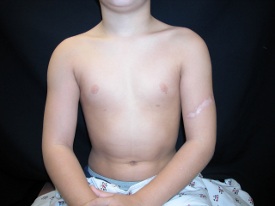Scleroderma

Scleroderma is a rare autoimmune, connective tissue disease resulting from excessive collagen formation that causes hardening and tightening of the skin and connective tissues. Scleroderma may be confined to the skin or progress to involve the body's organs, such as the heart, lungs, kidneys, and digestive tract. There are localized and systemic variants of scleroderma. The two types of localized scleroderma, called morphea and linear scleroderma, are uncommon. These types affect adults aged 30 to 50 years and occur more often in women than men. Scleroderma can run in families, but usually occurs without any family history.
Physical exam
The affected skin areas have thickened, shiny patches most commonly seen on the fingers, hands, face, and mouth. Some patients may have generalized swelling of the hands before these skin lesions appear. Patients may commonly have an exaggerated response to cold temperatures or stress that causes constriction of the superficial blood vessels resulting in the fingers or toes turning white, blue, and then red (called Raynaud's phenomenon). This can lead to pain and ulcerations in the fingers.
- In morphea, there are oval-shaped, thickened patches of skin that may have a surrounding purple border.
- In linear scleroderma, a band or streak of hardened skin may appear on the leg or arm or forehead.
- In systemic scleroderma, patients have involvement of the skin in addition to the internal organs. These patients may have difficulty swallowing, reflux, or heart, lung and kidney abnormalities. Lesions are often found on the trunk. In the progressive form of the disease, tightening of the skin occurs, causing a decreased ability to open the mouth and use the hands and over time leads to deterioration of body functions.
Treatment
- Topical or intralesional corticosteroids for scleroderma confined to the skin
- Oral corticosteroids for more severe cases
- D-Penicillamine for the progressive form of the disease
- Immunosuppressive medications such as methotrexate, mycophenolate mofetil (CellCept), cyclophosphamide (Cytoxan), or cyclosporine
- Blood pressure medications such as calcium channel blockers (nifedipine) to prevent the constriction of blood vessels in the fingers and toes
- Physical or occupational therapy to help maintain mobility
- Henry Ford Phototherapy with UVA-1 light can help the skin lesions
- Surgery
- Henry Ford Medical Dermatology
.svg?iar=0&hash=F6049510E33E4E6D8196C26CCC0A64A4)

/hfh-logo-main--white.svg?iar=0&hash=ED491CBFADFB7670FAE94559C98D7798)